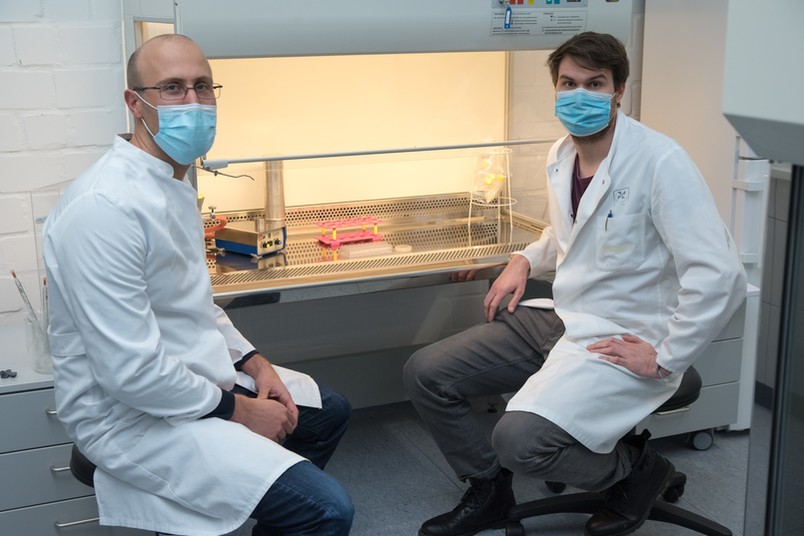Detecting bacteria with fluorescent nanosensors
Glowing carbon nanotubes indicate the presence of pathogens - quick and easy to use.

Researchers from Bochum, Göttingen, Duisburg and Cologne have developed a new method for detecting bacteria and infections. They use fluorescent nanosensors to detect pathogens faster and easier than it is possible with established methods. A team led by Prof. Dr. Sebastian Kruß, formerly at the University of Göttingen, now at the Ruhr-Universität Bochum (RUB), describes the results in the journal Nature Communications, published online on 25 November 2020. To detect bacteria using conventional methods, tissue samples have to be taken and analysed. The group led by Sebastian Kruß would like to eliminate the need to take samples and make pathogens visible directly at the site of infection using tiny optical sensors.
Fluorescence changes in the presence of bacterial molecules
The sensors are based on modified carbon nanotubes with a diameter of less than one nanometre. If they are irradiated with visible light, they then glow in the near-infrared range, which is not visible to humans, with a wavelength of about 1,000 nanometres and more. The fluorescence behaviour changes when the nanotubes encounter certain molecules in their environment. Since bacteria secrete a characteristic mix of molecules, the glow of the sensors can thus indicate the presence of certain pathogens. In this paper, the research team describes sensors for different bacterial motifs, the combination of which allows the detection and differentiation of dangerous pathogens associated with implant infections, for example. "The fact that the sensors work in the near-infrared range is particularly interesting for optical imaging because there are far fewer background signals in this range that can falsify the result," says Sebastian Kruß, who heads the Functional Interfaces and Biosystems group at RUB and is a member of the Ruhr Explores Solvation Cluster of Excellence, or Resolv for short. Light of this wavelength penetrates deeper into human tissue than visible light, which could make it possible to read the bacterial sensors even under wound dressings or on implants.
Further areas of application conceivable
»In the future, this could be the basis for the optical detection of infections on smart implants, for which sampling itself is no longer necessary. Thus, the healing process or a possible infection could be detected quickly, which could lead to improved patient care«,says Robert Nißler, first author of the study from the University of Göttingen. »However, the possible areas of application are not limited to this«, adds Kruß. »Better rapid diagnosis of blood cultures in the context of sepsis is also conceivable in the future.« In addition to the scientists from Physical Chemistry II at the Ruhr University Bochum and the Institute of Physical Chemistry at the University of Göttingen, teams from Medical Microbiology at the University Medical Center Göttingen, the University Medical Center Cologne and the Fraunhofer Institute for Microelectronic Circuits and Systems in Duisburg were also involved in the study.
Promotion
The Volkswagen Foundation and the Ruhr Explores Solvation cluster of excellence, Resolv for short, funded the work.
Original publication
Nißler et al.: Remote near infrared identification of pathogens with multiplexed nanosensors, in: Nature Communications, 2020, DOI: 10.1038/s41467-020-19718-5
Press contact
Prof. Dr Sebastian Kruß
Functional Interfaces and Biosystems
Faculty of Chemistry and Biochemistry
Ruhr University Bochum
Phone: +49 234 32 29946
Mail: sebastian.kruss@rub.de
Press release written by: Dr. Julia Weiler, Editorial Office of the Ruhr University Bochum (RUB)
You can find more information onwww.news.rub.de
About the Fraunhofer IMS
The Fraunhofer Institute for Microelectronic Circuits and Systems IMS in Duisburg is a globally recognized research institution for the development of innovative technologies and processes in microelectronics, smart sensor technologies and embedded artificial intelligence. In the business units "Health”, “Industry”, “Mobility”, “Space and Security”, scientists and engineers create innovative and sustainable solutions for the industry, the service sector and the society - for more than 30 years.
The Fraunhofer-Gesellschaft, headquartered in Germany, is the world’s leading applied research organization. With its focus on developing key technologies that are vital for the future and enabling the commercial exploitation of this work by business and industry, Fraunhofer plays a central role in the innovation process. As a pioneer and catalyst for groundbreaking developments and scientific excellence, Fraunhofer helps shape society now and in the future. Founded in 1949, the Fraunhofer-Gesellschaft currently operates 75 institutes and research institutions throughout Germany. The majority of the organization’s 29,000 employees are qualified scientists and engineers, who work with an annual research budget of 2.8 billion euros. Of this sum, 2.4 billion euros are generated through contract research.